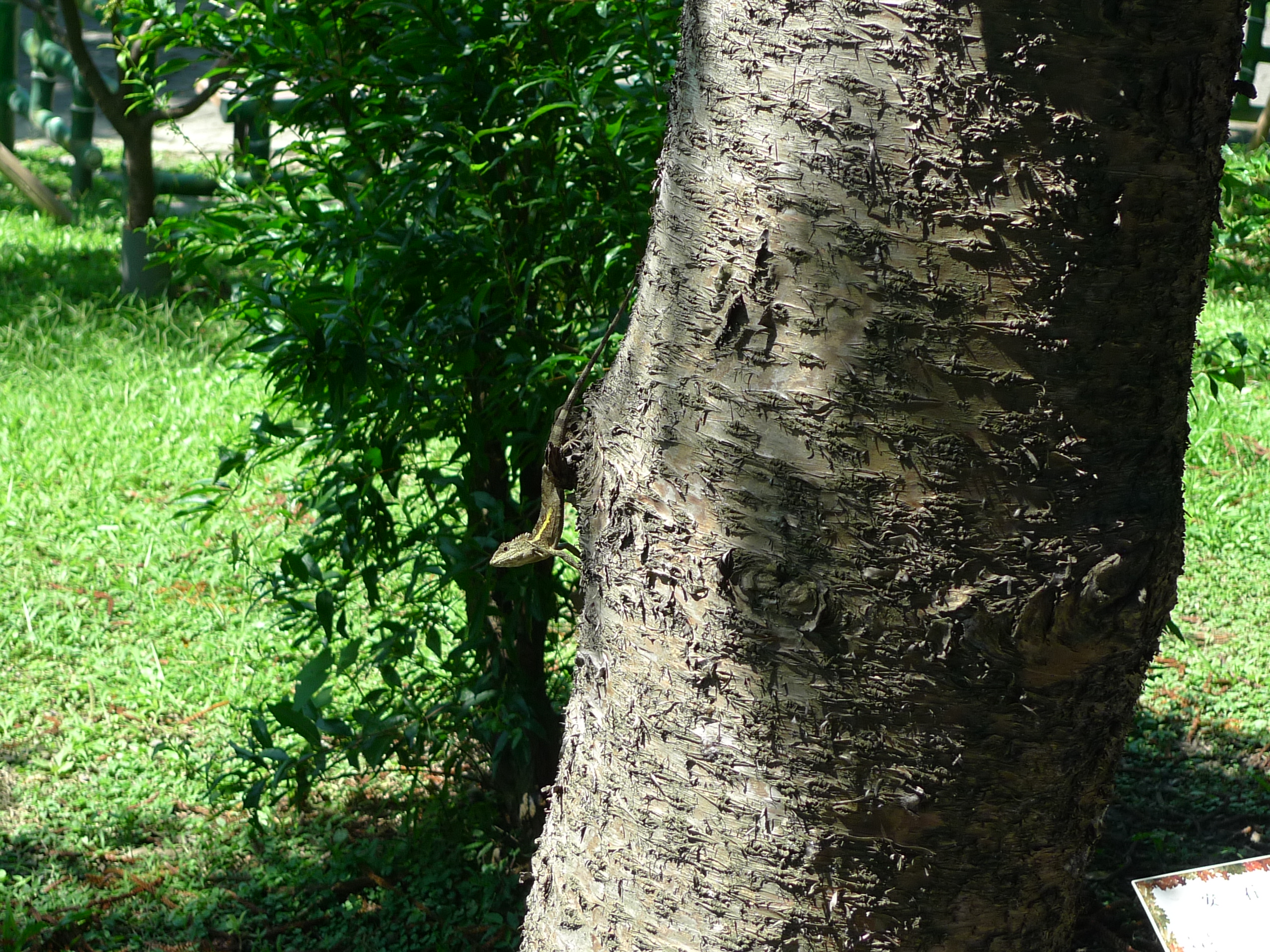|
Diploderma Luei
''Diploderma luei'' is a species of lizard in the Family (biology), family Agamidae. The species is Endemism, endemic to Taiwan. Geographic range In Taiwan ''D. luei'' has only been found in the mountains of Yilan County, Taiwan, Yilan County and Hualien County at elevations of . Description The snout-to-vent length (SVL) of ''D. luei'' may reach ; the total length (including the long tail) may reach . Reproduction ''D. luei'' is Oviparity, oviparous. Etymology The Specific name (zoology), specific name, ''luei'', comes from the name of Taiwanese herpetologist Kuang-Yang Lue, to honor his contributions to the herpetology of Taiwan.Beolens, Bo; Watkins, Michael; Grayson, Michael (2011). ''The Eponym Dictionary of Reptiles''. Baltimore: Johns Hopkins University Press. xiii + 296 pp. . (''Japalura luei'', p. 162). Conservation status ''D. luei'' is listed as a rare and valuable species in the ''Taiwan Wildlife Conservation Act'' similar to Diploderma swinhonis. References ... [...More Info...] [...Related Items...] OR: [Wikipedia] [Google] [Baidu] |
The IUCN Red List Of Threatened Species
The International Union for Conservation of Nature (IUCN) Red List of Threatened Species, also known as the IUCN Red List or Red Data Book, founded in 1964, is the world's most comprehensive inventory of the global conservation status of biological species. It uses a set of precise criteria to evaluate the extinction risk of thousands of species and subspecies. These criteria are relevant to all species and all regions of the world. With its strong scientific base, the IUCN Red List is recognized as the most authoritative guide to the status of biological diversity. A series of Regional Red Lists are produced by countries or organizations, which assess the risk of extinction to species within a political management unit. The aim of the IUCN Red List is to convey the urgency of conservation issues to the public and policy makers, as well as help the international community to reduce species extinction. According to IUCN the formally stated goals of the Red List are to provide sc ... [...More Info...] [...Related Items...] OR: [Wikipedia] [Google] [Baidu] |
Yilan County, Taiwan
Yilan County, alternately spelled I-lan, is a County (Taiwan), county in northeastern Taiwan, Republic of China. Name The name ''Yilan'' derives from the Taiwanese indigenous peoples, indigenous Kavalan people. Other former names in reference to this area in the Yilan Plain include ''Kabalan'', ''Kavalan'', ''Kavaland'', ''kap-a-lan'', ''Yiland'' and ''Gilan''. Before 2009, the county's official name was transliterated as Ilan. History Early history Since early ages, many people have traveled from far places to Yilan. Taiwanese aborigines, Indigenous tribes that have settled in Yilan are Kavalan people and Atayal people. The Kavalan people came by the sea and lived by the river at Yilan Plain since around 1,000 years ago. They mostly speak the Austronesian languages. Their settlements consisted of small villages along rivers with around 40-50 communities scattered around the area with a total population of approximately 10,000 people. The Atayal people came by crossing ... [...More Info...] [...Related Items...] OR: [Wikipedia] [Google] [Baidu] |
Endemic Fauna Of Taiwan
Endemism is the state of a species being found in a single defined geographic location, such as an island, state, nation, country or other defined zone; organisms that are indigenous to a place are not endemic to it if they are also found elsewhere. For example, the Cape sugarbird is found exclusively in southwestern South Africa and is therefore said to be ''endemic'' to that particular part of the world. An endemic species can be also be referred to as an ''endemism'' or in scientific literature as an ''endemite''. For example '' Cytisus aeolicus'' is an endemite of the Italian flora. '' Adzharia renschi'' was once believed to be an endemite of the Caucasus, but it was later discovered to be a non-indigenous species from South America belonging to a different genus. The extreme opposite of an endemic species is one with a cosmopolitan distribution, having a global or widespread range. A rare alternative term for a species that is endemic is "precinctive", which applies to s ... [...More Info...] [...Related Items...] OR: [Wikipedia] [Google] [Baidu] |
Reptiles Of Taiwan
Reptiles, as most commonly defined are the animals in the class Reptilia ( ), a paraphyletic grouping comprising all sauropsids except birds. Living reptiles comprise turtles, crocodilians, squamates (lizards and snakes) and rhynchocephalians (tuatara). As of March 2022, the Reptile Database includes about 11,700 species. In the traditional Linnaean classification system, birds are considered a separate class to reptiles. However, crocodilians are more closely related to birds than they are to other living reptiles, and so modern cladistic classification systems include birds within Reptilia, redefining the term as a clade. Other cladistic definitions abandon the term reptile altogether in favor of the clade Sauropsida, which refers to all amniotes more closely related to modern reptiles than to mammals. The study of the traditional reptile orders, historically combined with that of modern amphibians, is called herpetology. The earliest known proto-reptiles originated around 31 ... [...More Info...] [...Related Items...] OR: [Wikipedia] [Google] [Baidu] |
Lizards Of Asia
Lizards are a widespread group of squamate reptiles, with over 7,000 species, ranging across all continents except Antarctica, as well as most oceanic island chains. The group is paraphyletic since it excludes the snakes and Amphisbaenia although some lizards are more closely related to these two excluded groups than they are to other lizards. Lizards range in size from chameleons and geckos a few centimeters long to the 3-meter-long Komodo dragon. Most lizards are quadrupedal, running with a strong side-to-side motion. Some lineages (known as "legless lizards"), have secondarily lost their legs, and have long snake-like bodies. Some such as the forest-dwelling ''Draco'' lizards are able to glide. They are often territorial, the males fighting off other males and signalling, often with bright colours, to attract mates and to intimidate rivals. Lizards are mainly carnivorous, often being sit-and-wait predators; many smaller species eat insects, while the Komodo eats mammals as b ... [...More Info...] [...Related Items...] OR: [Wikipedia] [Google] [Baidu] |
Diploderma
''Diploderma'' is a genus of lizards in the family Agamidae. Species of ''Diploderma'' are native to Myanmar, China, Vietnam, Taiwan, and Japan. Most of the species are found in China, including many endemics. Species The following 42 species are recognized as being valid: ''Nota bene'': a binomial authority In taxonomy, binomial nomenclature ("two-term naming system"), also called nomenclature ("two-name naming system") or binary nomenclature, is a formal system of naming species of living things by giving each a name composed of two parts, bot ... in parentheses indicates that the species was originally described in a genus other than ''Diploderma''. References Further reading * Hallowell E (1861). "Report upon the Reptilia of the North Pacific Exploring Expedition, under command of Capt. John Rogers, U. S. N." ''Proceedings of the Academy of Natural Sciences of Philadelphia'' 12: 480-510. (''Diploderma'', new genus, p. 490; ''D. polygonatum'', new species, pp. ... [...More Info...] [...Related Items...] OR: [Wikipedia] [Google] [Baidu] |
Diploderma Swinhonis
''Diploderma swinhonis'', also known commonly as the Taiwan japalure, Swinhoe's japalure, Swinhoe's lizard, and Swinhoe's tree lizard (), is a species of lizard in the family Agamidae. The species is native to Taiwan. It is considered an invasive alien species in Japan after likely being transported from Taiwan by humans. A foraging ambush predator, this lizard preys primarily on arthropods and thus remains at the bottom of forests perched on trees where sunlight is present. Diploderma swinhonis is not a major threat to humans and is able to adapt to a variety of habitats, including urban environments. Male Diploderma swinhonis are physically distinct from females, with their body sizes being much larger and having a yellow stripe. These lizards sexually reproduce on a seasonal basis and hibernate during the winter time. Etymology Both the specific name, ''swinhonis'', and some of the common names are in honour of English naturalist Robert Swinhoe. In Latin, its genus can be ... [...More Info...] [...Related Items...] OR: [Wikipedia] [Google] [Baidu] |
Specific Name (zoology)
In zoological nomenclature, the specific name (also specific epithet or species epithet) is the second part (the second name) within the scientific name of a species (a binomen). The first part of the name of a species is the name of the genus or the generic name. The rules and regulations governing the giving of a new species name are explained in the article species description. For example, the scientific name for humans is ''Homo sapiens'', which is the species name, consisting of two names: ''Homo'' is the " generic name" (the name of the genus) and ''sapiens'' is the "specific name". Historically, ''specific name'' referred to the combination of what are now called the generic and specific names. Carl Linnaeus, who formalized binomial nomenclature, made explicit distinctions between specific, generic, and trivial names. The generic name was that of the genus, the first in the binomial, the trivial name was the second name in the binomial, and the specific the proper term for ... [...More Info...] [...Related Items...] OR: [Wikipedia] [Google] [Baidu] |
Oviparity
Oviparous animals are animals that lay their eggs, with little or no other embryonic development within the mother. This is the reproductive method of most fish, amphibians, most reptiles, and all pterosaurs, dinosaurs (including birds), and monotremes. In traditional usage, most insects (one being ''Culex pipiens'', or the common house mosquito), molluscs, and arachnids are also described as oviparous. Modes of reproduction The traditional modes of reproduction include oviparity, taken to be the ancestral condition, traditionally where either unfertilised oocytes or fertilised eggs are spawned, and viviparity traditionally including any mechanism where young are born live, or where the development of the young is supported by either parent in or on any part of their body. However, the biologist Thierry Lodé recently divided the traditional category of oviparous reproduction into two modes that he named ovuliparity and (true) oviparity respectively. He distinguished the tw ... [...More Info...] [...Related Items...] OR: [Wikipedia] [Google] [Baidu] |
Hualien County
Hualien County (Mandarin Wade–Giles: Hua¹-lien² Hsien⁴; Pīnyīn: ''Huālián Xiàn''; Hokkien POJ: ''Hoa-lian-koān'' or ''Hoa-liân-koān''; Hakka PFS: ''Fâ-lièn-yen''; Amis: ''Kalingko'') is a county on the east coast of Taiwan. It is the largest county by area, yet due to its mountainous terrain, has one of the lowest populations in the country. The county seat and largest city is Hualien City. Most of the population resides in the Huadong Valley, which runs north to south, sandwiched between the Central and Hai'an mountain ranges. Due to the rural nature of the county, Hualien attracts many visitors for its natural environment, which includes Taroko Gorge, Qingshui Cliff and Qixingtan Beach. History Early history Modern-day Hualien City was originally called ''Kilai'' (), after the Sakiraya Taiwanese aborigines and their settlement. Spanish settlers arrived in 1622 to pan for gold. Picking up the sounds of native words, these settlers called the area ''Turumoa ... [...More Info...] [...Related Items...] OR: [Wikipedia] [Google] [Baidu] |
Taiwan
Taiwan, officially the Republic of China (ROC), is a country in East Asia, at the junction of the East and South China Seas in the northwestern Pacific Ocean, with the People's Republic of China (PRC) to the northwest, Japan to the northeast, and the Philippines to the south. The territories controlled by the ROC consist of 168 islands, with a combined area of . The main island of Taiwan, also known as ''Formosa'', has an area of , with mountain ranges dominating the eastern two-thirds and plains in the western third, where its highly urbanised population is concentrated. The capital, Taipei, forms along with New Taipei City and Keelung the largest metropolitan area of Taiwan. Other major cities include Taoyuan, Taichung, Tainan, and Kaohsiung. With around 23.9 million inhabitants, Taiwan is among the most densely populated countries in the world. Taiwan has been settled for at least 25,000 years. Ancestors of Taiwanese indigenous peoples settled the isla ... [...More Info...] [...Related Items...] OR: [Wikipedia] [Google] [Baidu] |

.jpg)




